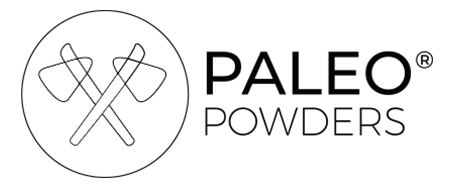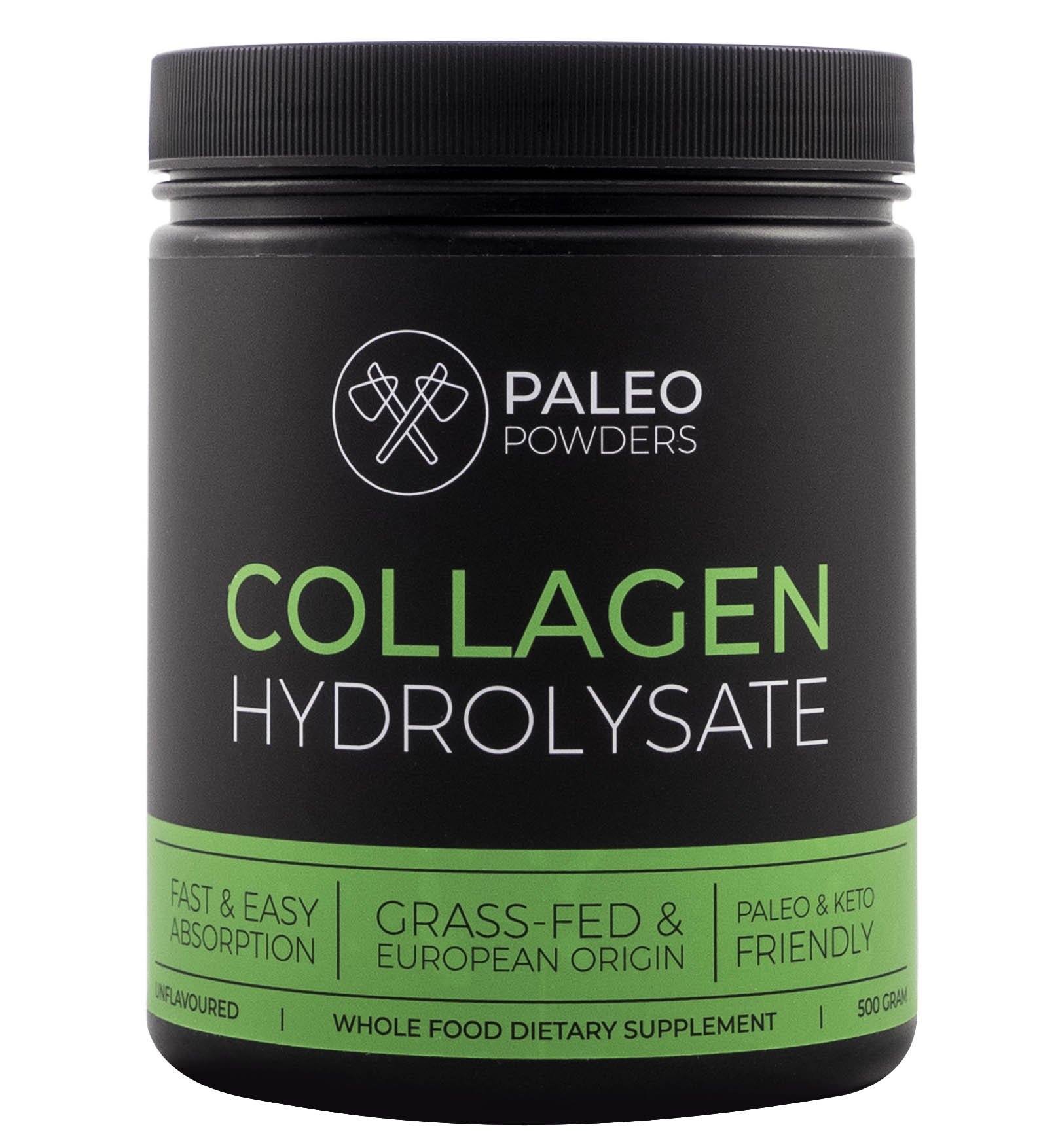
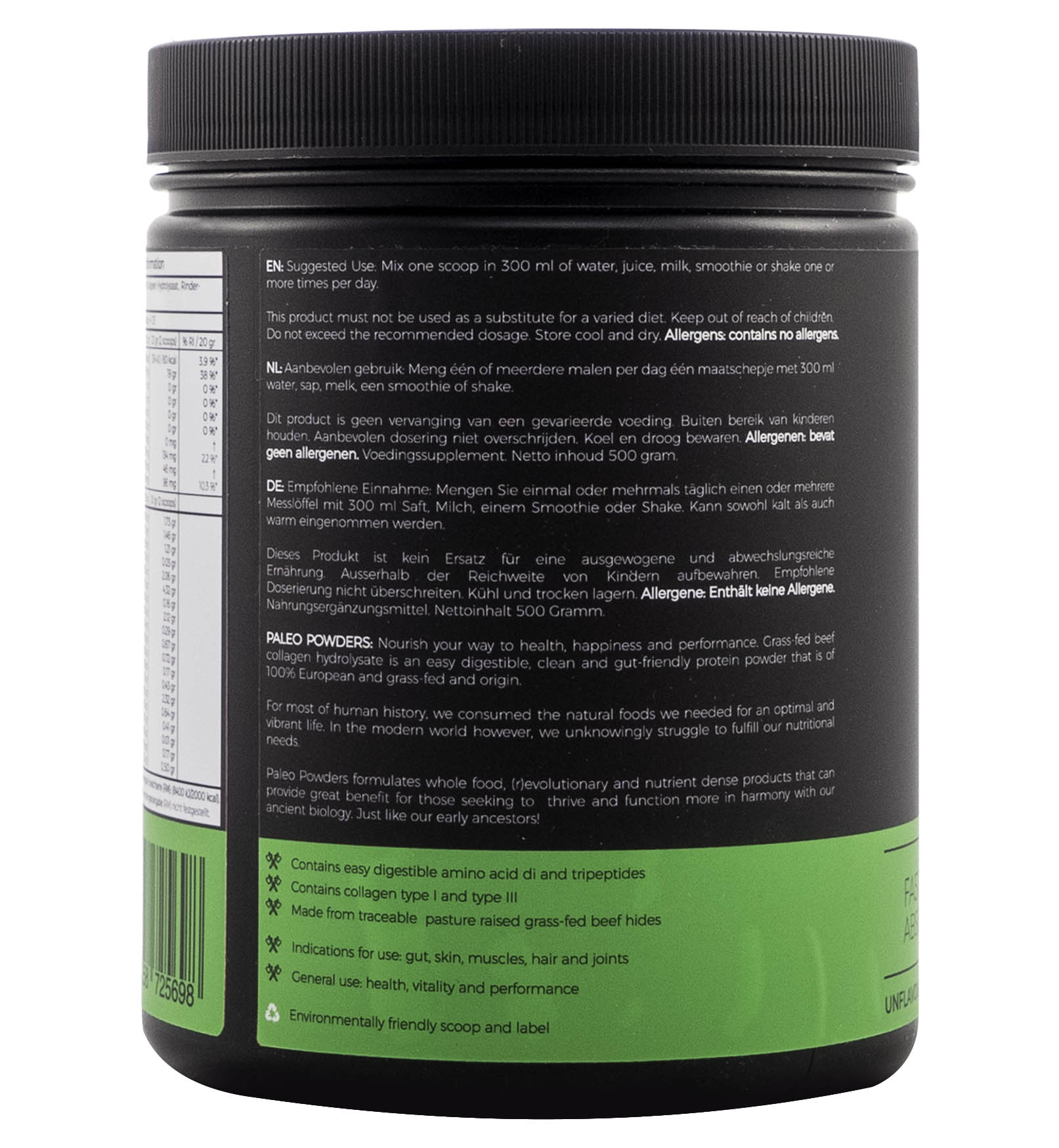
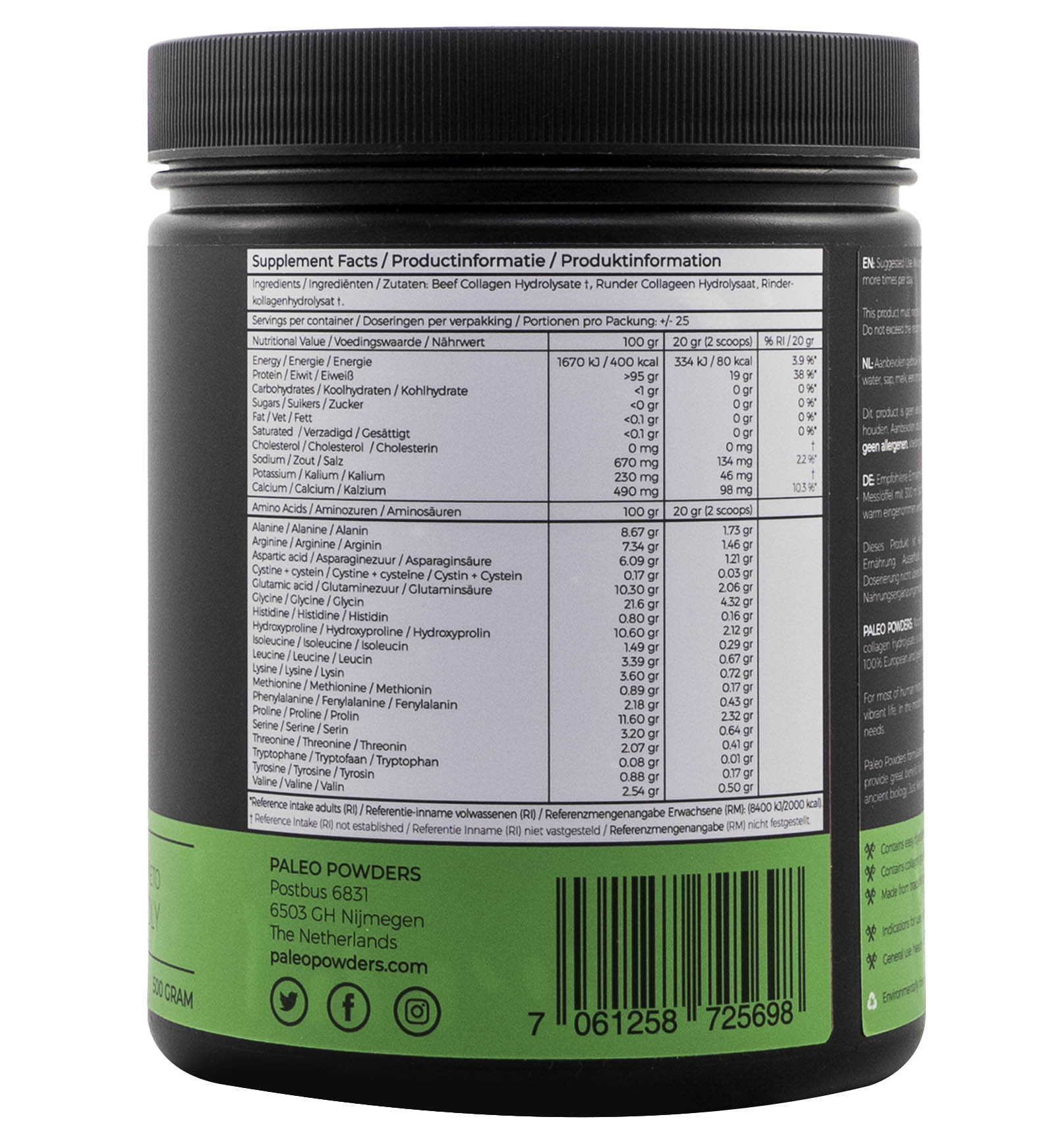
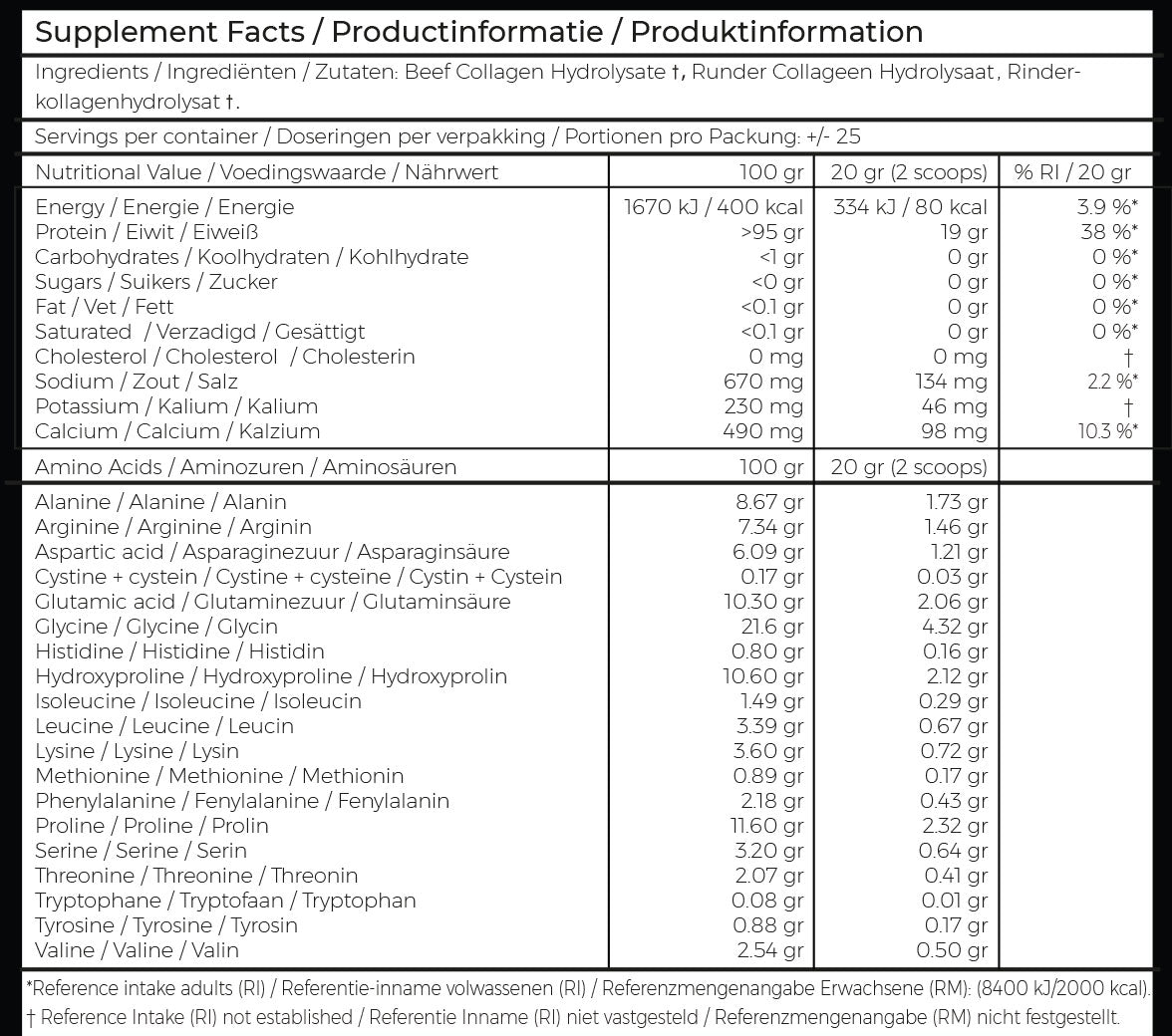

Collageen Hydrolysaat - Grasgevoerde Runderen - 500 gram
Collageen Hydrolysaat is het ultieme nutricosmetic supplement voor je huid, haar en nagels! Ruim 70% van de eiwitten in je huid bestaat uit collageen. Maar collageen is niet beperkt tot de buitenkant van het lichaam.
Collageen Hydrolysaat wordt bijna overal in het lichaam aangetroffen. Het is ook de "cellulaire lijm" die helpt om alle bindweefsel in je lichaam bij elkaar te houden. Collageen biedt de structuur voor je botten, spieren, pezen, gewrichtskraakbeen, haren en de inwendige organen, inclusief het gehele spijsverteringsstelsel.
De veelzijdige rol van collageen hydrolysaat
Collageen speelt dus niet alleen een cruciale rol in je uiterlijk, ook in hoe je je voelt en uiteindelijk ook hoe goed je lichaam functioneert in algemene zin., maar het is het meest aanwezig in de huid, botten, pezen en ligamenten. Het houdt al onze weefsels bij elkaar en voorziet het skelet van een stevige maar flexibele structuur. Collageen dat je via voeding of supplementen binnenkrijgt verhoogt je lichaamseigen collageen voorraad.
Het op peil houden van goede niveaus en een toereikende dagelijkse inname van collageen is een interessant onderdeel de verzorgende voeding die het lichaam evolutionair gewend is.
Voordelen van Collageen Hydrolysaat:
- Neutrale smaak en lost snel op
- Bevat belangrijke aminozuren zoals glycine, proline en hydroxyproline
- Geschikt voor een keto-dieet: bevat 0 gram suiker
- Bevat collageen type I en III
- Meer dan 95% eiwit per dosering
- Afkomstig uit Europa, met gegarandeerde kwaliteit
- Uitsluitend van grasgevoerde weiderunderen
- Bevat 500 gram per pot
Waarom heb je collageen nodig?
- Net zoals alle andere weefsels in je lichaam zoals spieren, botten en zelfs je hersenen, heeft de collageen in je lichaam input uit de omgeving en voeding voor de werking en kwaliteit.
- Tegen de tijd dat je 40 jaar bent, daalt het vermogen van je lichaam om zijn eigen collageen te produceren ongeveer 25%. Op 60-jarige leeftijd is uw productie ruim boven de helft van de jeugdige niveaus. In tegenstelling tot wijsheid, staat de tijd niet aan jouw kant waar het gaat om collageen. Door het nemen van collageen ondersteun je het lichaamseigen collageennetwerk
- Collageen is nodig om evenwicht te brengen in het moderne voedingspatroon. Vandaag de dag wordt bijna alleen maar mager spiervlees gegeten. Mager spiervlees is hoog in het aminozuur l-methionine, en erg laag in het aminzouur glycine. Bij Collageen is het tegenovergestelde het geval; laag in L-Methionine en hoog in Glycine.
Upgrade jezelf van binnenuit met Collageen Hydrolysaat
Het verhogen van je collageen inname kan op verschillende manieren, bijvoorbeeld door het consumeren van bottenbouillon (bone broth), stoofschotels en de stuggere vleesdelen. Je kan ook een hoogwaardig collageen hydrolysaat poeder gebruiken van grasgevoerde weiderunderen. Deze laatste optie is een zeer handige en praktische manier om je dieet aan te vullen met dit voedzame en unieke samenstelling van belangrijke aminozuren. Door het nemen van collageen ondersteun je het lichaamseigen collageennetwerk.
Glycine, lysine & (hydroxy)proline
Collageen bevat niet alle essentiële aminozuren, hierdoor is het een onvolledig eiwit. Maar de aminozuren die het bevat, zijn bijzonder belangrijk, vooral glycine. Andere belangrijke aminozuren zijn glutamine, lysine, (hydroxy)proline. Het aminozuurprofiel van collageen verschilt aanzienlijk van het aminozuurprofiel van mager vlees: deze profielen zijn echt complementair aan elkaar en brengen elkaar eigenlijk in evenwicht. Hoogstwaarschijnlijk precies zoals de natuur het bedoeld heeft! In tegenstelling tot collageen bevat spiervlees hoge niveaus van L-methionine en lage niveaus van glycine. Een goede balans tussen deze twee aminozuren lijkt van bijzonder belang te zijn voor de gezondheid en levensduur.
Paleo- en keto goedgekeurd
Collageen hydrolysaat wordt gemaakt met paleo-goedgekeurde ingrediënten op basis van paleo-verantwoordelijke bronnen. Het past ook uitstekend in een ketogeen dieet omdat collageen hydrolysaat 0 gram suikers bevat. Met de geprezen voedingswaarde van Europese runderen die grasgevoerd zijn, is de poeder niet alleen voedzaam maar ook handig in gebruik. Het onderhouden van je eigen collageennetwerken was nog nooit zo eenvoudig op een paleo verantwoorde manier. Collageenhydrolysaat is bovendien licht verteerbaar en wordt snel opgenomen.
100% Europese herkomst
Collageenpeptiden worden gemaakt van grasgevoerde Europese weidekoeien. Tijdens de wintermaanden worden de koeien binnen gehuisvest. Hier krijgen ze gelukkig nog steeds natuurlijke en voedzame grassen in de vorm van kuilvoer (gefermenteerd gras) of hooi. Aanvullende voederconcentraten worden zo min mogelijk gebruikt en alleen wanneer dit echt nodig is om een optimale diergezondheid te behouden. Het verantwoord inkopen van onze collageen in Europa, verhoogt de duurzaamheid. Paleo Powders collageen is de beste keuze op het gebied van kwaliteit, duurzaamheid en milieufilosofie! In tegenstelling tot intensieve bio-industrie collageen of collageen afkomstig uit Amerika of Azië.
Gemaakt van voedzame botten
Onze collageen wordt gemaakt van hoogwaardige runderbotten, die op een natuurlijke en milde wijze worden gehydrolyseerd door enzymen. Hierdoor hebben de peptiden een laag moleculair gewicht van 3-6 kDa. De smaak is zeer neutraal waardoor het een ideaal ingrediënt is voor shakes, smoothies en zelfs recepten. Vanwege het lage moleculaire gewicht worden de collageenpeptiden effectief en snel opgenomen. Met meer dan 95% eiwit per dosering is dit voedingssupplement zo puur en hoogwaardig mogelijk als het maar kan zijn.
Kwaliteit is belangrijk
Collageenpoeders hebben niet allemaal dezelfde kwaliteit. In 2020 analyseerde het Clean Label Project 30 collageen producten op de zware metalen arseen, cadmium, lood en kwik. Het rapport toonde aan dat bij 100% van de geteste collageen supplementen de kwikniveaus binnen de veilige voedselnormen viel. 34% bevatte echter wel lage meetbare concentraties. 37% testte echter positief op hoge concentraties lood en 17% positief op hoge concentraties cadmium.
Diervriendelijk en duurzaam inkopen lost een groot deel van deze problemen op. In het genoemde rapport wordt benadrukt dat verontreiniging van zware metalen een bijproduct is van geconcentreerde diervoeding en dierverwerking. Gelukkig kiezen wij enkel en alleen voor Europese grasgevoerde en weide-grazende bronnen voor onze collageen hydrolysaat. Een andere factor die volgens het verslag bijdraagt aan de verontreiniging van zware metalen is luchtvervuiling. Dit is helaas een feit in de moderne wereld, maar kan worden opgelost met de juiste verwerkingstechnologieën.
Getest op zware metalen
Kwaliteitscontrole, productveiligheid en transparantie zijn voor ons erg belangrijk. Daarom screenen wij ieder analysecertificaat grondig worden alle nieuwe batches in een onafhankelijk laboratorium dubbel geanalyseerd. Hiermee verzekeren wij de kwaliteit! De typische waarden van zware metalen in onze collageen hydrolysaat:
- Arseen (As) < 0,10 mg/kg = < 0,1 PPM
- Cadmium (Cd) < 0,01 mg/kg = < 0,01 PPM
- Lood (Pb) < 0,05 mg/kg = < 0,05 PPM
- Kwik (Hg) < 0,005 mg/kg = < 0,005 PPM
Verschil Collageen, Bone Broth & Kefir
|
Collagen Hydrolysaat |
Bone Broth |
Kefir Whey |
|
Neutrale smaak |
Mild hartig |
Romig |
|
Snelle opname |
Normal absorption |
Snelle opname |
|
Gehydrolyseerd |
Niet gehydrolyseerd |
Semi gehydrolyseerd |
|
Collageen type I & III |
Collagen type I t/m 5 |
Geen collageen |
|
Enzymatisch |
Langzaam getrokken |
Kefir gefermenteerd |
|
95% eiwitten |
98% eiwitten |
90% eiwitten |
|
95% collageen |
78-84% collageen |
0% collageen |
|
Geen zuivel |
Geen zuivel |
Zuivel wei |
|
0% vet |
2-5% vet |
0% vet |
|
0% suikers |
0% suikers |
0% suikers |
|
Glycine 21.6% |
Glycine 20% |
Glycine 1.5% |
|
BCAA’s 7.42% |
BCAA’s 8.4% |
BCAA’s 23.75% |
|
Hydroxyproline 10.6% |
Hydroxyproline 10.2% |
Hydroxyproline 0% |
|
Uit botten |
Vlezige botten |
Weidemelk |
|
Geen glucosamine |
Bevat glucosamine |
Geen glucosamine |
| Geen chondroïtine | Bevat chondroïtine | Geen chondroïtine |
| Geen hyaluronzuur | Bevat hyaluronzuur | Geen hyaluronzuur |
Oer-achtergrond
Onze voorouders uit het jager-verzamelaar-tijdperk, en zelfs vele generaties erna, aten veel meer collageen dan wij nu doen. Dat kwam door hun grote afhankelijkheid van dierlijk voedsel. Ze aten het dier altijd van neus tot staart: ze consumeerden dus het hele dier. Inclusief huid, pezen en andere gelatineachtige delen. Zeedieren of landdieren of een combinatie van beide: van neus tot staart eten was de norm!
Migratie: meer carnivoor eten
Het is bekend dat wanneer de jager-verzamelaars vanaf de evenaar wegtrokken naar het noorden ze minder planten konden eten. Hoe kouder het werd, des te minder planten er van nature groeien. Aangezien het plantaardig voedsel aanzienlijk afneemt met toenemende breedtegraden, werd dit gecompenseerd met dierlijk voedsel. Prehistorische jager-verzamelaarsgroepen haalde over het algemeen ongeveer 50% van hun voeding uit dierlijke bronnen. Moderne jager-verzamelaarssamenlevingen halen ongeveer 60% van hun voeding uit dierlijke bronnen.
Neus-tot-staart concept
In de prehistorie zou het eten van enkel mager spiervlees, zonder de vetten, organen, klieren en collageenweefsels niet voldoende zijn geweest om te gedijen, of zelfs om te overleven. Een aanzienlijk deel van de dierlijke voedselbronnen zou in voedingsrijke en collageenrijke weefsels voorzien. In de moderne wereld eten we over het algemeen voornamelijk mager spiervlees. Wij hebben het eten van neus-tot-staart decennia terug opgegeven. Collageenrijk vlees of taai vlees of andere dierlijke delen hebben vandaag de dag niet meer de voorkeur boven het meer magere en malse vlees.
Het verschil tussen historische en moderne dagelijkse collageenconsumptie is dus opvallend. Vegetariërs en veganisten hebben de neiging om nóg minder collageen te consumeren dan al het geval is. Op basis van een paleo-perspectief, dat het neus-tot-staart-eetconcept uitdraagt, is het belangrijk om voldoende collageen te eten.
Fascinerende collageen dynamiek
Collageen onderhoud en kwaliteit zijn niet alleen afhankelijk van een adequate dagelijkse voeding maar ook van mechanische stress op het lichaam zoals bij sporten en bewegen. Collageen kan namelijk haar kristalliniteit snel veranderen als reactie op fysieke krachten. Zo verandert de kristalliniteit en de rangschikking van collageenmoleculen van bijvoorbeeld het kraakbeen in je knieën bij iedere stap die je zet. Door de veranderende mechanische belasting van iedere knie tijdens een stap schiet de structurele staat van het collageen heen en weer. De uitspraak "Use it or lose it" geldt niet alleen spieren en botten maar dus ook voor collageenweefsel. Belast je je weefsels niet voldoende met de juiste prikkels dan verliezen ze kwaliteit en functionaliteit! Veel en divers bewegen maakt deel uit van ons menselijke erfgoed. Gelukkig is het een integraal onderdeel van een paleo-levensstijl.
Synergie tussen collageen & water
Water is een andere belangrijke paleolithische factor die relevant is voor je collageen. Na water is collageen de meest voorkomende stof in je lichaam. In een natuurlijke staat bevat 60% van het gewicht van collageen uit water. Water is dus een integraal onderdeel van collageen. Watermoleculen kunnen zich stevig binnen aan collageen en volgen netjes en ordelijk de helixvorm. De complexe dynamiek van watermoleculen in gehydrateerd collageenweefsel speelt een belangrijke rol bij het bepalen van de structurele en functionele eigenschappen. Met andere woorden; goede hydratatie is belangrijk voor je collageen. Zorg daarom goed voor de werking van je mitochondriën en drink dagelijks voldoende zuiver water. Naast beweging en voeding zou dit bovenaan ieders lijst moeten staan als het gaat om collageengezondheid en -functie.
Hiërarchie van gezondheidsfactoren
Natuurlijk zijn slaap, earthing en verstandige blootstelling aan zonlicht eveneens kritieke factoren die gezonde collageenniveaus en collageenfunctie in het hele lichaam ondersteunen. Slaap zorgt voor een langere periode van herstel, terwijl zonlicht rood en bijna-infrarood licht biedt, vooral rond zonsopgang en zonsondergang. Earthing, contact met blote voeten op de aarde, voorziet het bindweefselmatrix van elektronen uit de aarde.
Het meest voorkomende eiwit
Wist je dat er veel soorten “meest voorkomende” eiwitten in de natuur zijn? Collageen is bijvoorbeeld het meest voorkomende eiwit in het dierenrijk. Er zijn tenminste 16 soorten collageen, maar 80-90% van het collageen in het lichaam bestaat uit de typen I, II en III. Actine is het meest voorkomende eiwit in de meeste eukaryotische cellen. Het is sterk geconserveerd en neemt deel aan meer eiwit-eiwit interacties dan enig ander bekend eiwit. Deze eigenschappen maken actine een kritische speler in veel cellulaire functies. In het plantenrijk vinden we RuBisCO (ribulose-1,5-bisphosphate carboxylase-oxygenase). Het wordt beschouwd als het meest voorkomende eiwit ter wereld, omdat het aanwezig is in iedere plant die fotosynthese en moleculaire synthese ondergaat tijdens de Calvincyclus. Er is berekend dat rubisco 20-25% van het oplosbare eiwit in bladeren uitmaakt. Het wordt geproduceerd met een snelheid van ongeveer 1000 kg/s op aarde.
Samenvatting Collageen Hydrolysaat
Collageen Hydrolysaat is dus niet alleen een supplement voor je uiterlijk, maar ook voor het innerlijke systeem. Meer dan 70% van de eiwitten in je huid bestaat uit collageen maar de werking stopt dus niet aan de oppervlakte! Collageen vind je door je hele lichaam, als een soort "cellulaire lijm" die het bindweefsel samenbrengt en een stevige structuur biedt aan botten, spieren, pezen, gewrichtskraakbeen, en zelfs je spijsverteringsstelsel.
Bovendien is Collageen Hydrolysaat van runderen een uitstekend alternatief voor bijvoorbeeld viscollageen, vooral voor diegenen met allergieën. Met de voordelen van Collageen Hydrolysaat, waaronder belangrijke aminozuren, een hoog eiwitgehalte, en een lichte verteerbaarheid is collageen een supplement voor iedere dag en voor eigenlijk iedereen!
Inhoud
Gebruiksaanwijzing
INGREDIËNTEN
Opties kiezen





